Unit 10 Reading教学设计
M4 U10 L1 A Material World教学设计
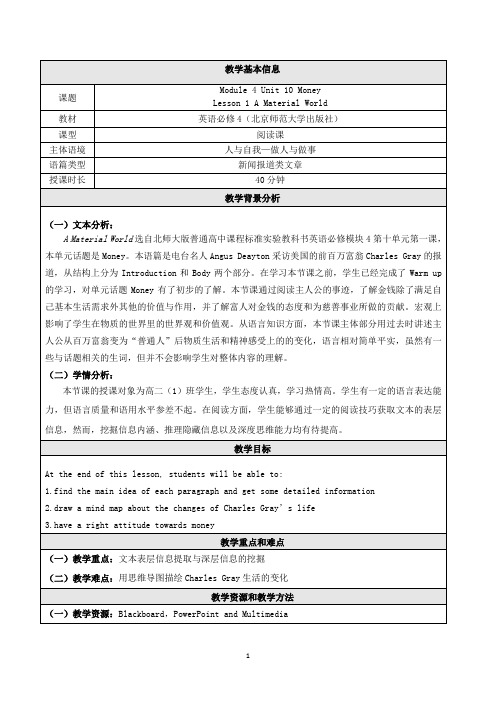
(一)教学重点:文本表层信息提取与深层信息的挖掘
(二)教学难点:用思维导图描绘Charles Gray生活的变化
教学资源和教学方法
(一)教学资源:Blackboard,PowerPoint and Multimedia
(二)教学方法:问题启发式、合作讨论式
教学过程
教学步骤
时间分配和活动方式
教学基本信息
课题
Module 4 Unit 10 Money
Lesson 1 A Material World
教材
英语必修4(北京师范大学出版社)
课型
阅读课
主体语境
人与自我—做人与做事
语篇类型
新闻报道类文章
授课时长
40分钟
教学背景分析
(一)文本分析:
A Material World选自北师大版普通高中课程标准实验教科书英语必修模块4第十单元第一课,本单元话题是Money。本语篇是电台名人Angus Deayton采访美国的前百万富翁Charles Gray的报道,从结构上分为Introduction和Body两个部分。在学习本节课之前,学生已经完成了Warm up的学习,对单元话题Money有了初步的了解。本节课通过阅读主人公的事迹,了解金钱除了满足自己基本生活需求外其他的价值与作用,并了解富人对金钱的态度和为慈善事业所做的贡献。宏观上影响了学生在物质的世界里的世界观和价值观。从语言知识方面,本节课主体部分用过去时讲述主人公从百万富翁变为“普通人”后物质生活和精神感受上的的变化,语言相对简单平实,虽然有一些与话题相关的生词,但并不会影响学生对整体内容的理解。
学习能力:
自主学习
文化意识:
了解百万富翁Charles Gray做慈善的事迹,形成正确的价值观
《Unit 10 If you go to the party, you'll have a great time》教学设计 (5课时)

【课题】
Unit10 If you go to the party. You will have a good time.
【学习
目标】
Key words and phrases: go to the party,have a good time, organize, video,
Ss improve their listening and speaking skills.
【学法
指导】
Speaking and listening
【教学
过程】
Ⅰ. Lead-in
Ask some questions.
T: If you are happy, what will you do?
S: If I am happy, I will smile.
(1) I think I’m going to stay at home.
If you do, you’ll be bored.
(2) I think I’m going to work until night.
If you do, you’ll be tired.
(3) I think I’m going to exercise.
Ⅲ. Game
1. Show some pictures in the big screen. Let Ss ask and answer like this:
A: What are you going to do …?
B: I think I’m going to….
《Unit 10 I've had this bike for three years 》 教学设计

Unit 10 I've had this bike for three years. 教学设计教材来源:初中九年级《英语》教科书/人民教育出版社2013版内容来源:九年级英语第十单元主题:Unit 10 I've had this bike for three years.课时:共五个课时,第2课时一、授课对象:二、目标确定的依据1、课程标准相关要求根据义务教育英语课程标准初中阶段四级教学目标的要求,八年级的学生应能从简单的文章中找出有关的信息,理解大意;能根据上下文猜测生词的意思。
2、教材分析本单元是人教版《新目标英语》八年级下册的第十单元,本单元主要讨论拥有的物品,使学生珍惜自己所拥有的物品并尽力去帮助其他人。
3、学情分析由于第八和第九单元的学习,学生已经对现在完成时态有了初步的学习,学生已经具有了相关的语言知识储备。
二、学习目标1.通过师生互助,能够正确地拼读单词短语并能准确运用。
(重点)2.通过自主阅读和同伴合作,能够读懂本篇文章并完成相关练习。
(难点)3.通过本节课的学习,能珍惜自己所拥有的物品并尽力去帮助别人。
四、设计思路本节课的教学内容是人教版新目标八年级Unit 10 I've had this bike for three years.在授课过程中采用的是“词汇-阅读-释义”的阅读模式。
首先,本节课讲解了单词。
主要通过以下的方式帮助学生学习新单词:1.通过图片掌握新词,实践了模象直观在教学中运用。
2.通过在不同句型里面呈现新单词,让学生大胆去猜测单词的词性和意思。
3.根据以旧引新的原则,让学生先回忆旧词再学习新词,并根据构词法让学生掌握词汇词性转换规律。
其次,按照先粗读再细读的阅读步骤。
先让学生先粗读了解文章的大意,并完成文章结构图。
再让学生细读文章并完成书本上3b和3C习题。
最后,通过组内合作,让学生积极讨论文中重点句子并指出句中的知识点,并完成相关的中招真题。
【教案】Welcome+Unit+Reading+for+Writing必修第一册(人教版2019)

Reading for Writing教学设计基本信息科目英语年级册次高一必修一WelcomeUnit姓名学校教材分析本课内容的主题语境属于:人与自我------学校生活。
语篇类型为非正式的自我介绍文本。
【What】本节课的话题是自我介绍。
该话题属于主题语境--人和自我,主题群--生活与学习。
子话题为个人、家庭、社区及学校生活;认识自我、丰富自我和了解自我;未来职业发展趋势,个人职业倾向、未来规划等。
本节课的文本是15岁的美国学生Ann与16岁的南非学生Thando的两则学生档案。
档案中包括学生的生活照片,以标题形式列出的个人姓名、年龄、学校及国籍的基本信息,以及一段关于各自的性格、兴趣爱好与理想等情况的文字自我介绍。
【Why】本篇阅读材料内容贴合学生生活,能够极大的引发学生的阅读兴趣和探究愿望。
自我介绍是学生今后人生中经常会用到的应用文之一,实用性很强。
材料中的Ann与Thando都是与学生同龄的高中生,可以让学生有代入感。
两人来自不同国家,有不同的性格和理想,学生通过学习、对比、联系自身实际并互相交流,可以对新入高中的自己和新同学们都有更好的认识,同时提高语言运用能力和思维能力。
另外,材料中体现出Ann和Thando具有积极乐观、好学向上的品质,这些也对学生起到了良好的榜样作用。
【How】本节课文本是两篇个人简介,分别从姓名、年龄、学业、个人性格和爱好等方面进行了概述性介绍。
第一部分为女生介绍,第二部分为男生介绍,介绍既有相同内容,都使用一般现在时,也有鲜明的个人风格,只言片语中生动地展现了不同人物特质。
文本词汇基本属于义务教育阶段的必会词汇,容易理解;句式也基本是简单句和并列句,仅在第二篇简介中,使用了两次if引导的条件状语从句。
相对来说,第二部分句型表达更丰富一些,描写更生动一些,比如使用了句型You’ll never see me without... 和either...or...强调作者喜欢读书和学习;在表达对未来的期望时,第一部分用了I plan to become的结构,而第二部分用了My dream is to start...动词不定式做表语的结构。
外研版小学英语六年级上册单元教案-Module10教案

外研版小学英语单元教案Module 10知识与技能:全体学生能朗读课文,阅读相关短文,并能按要求完成语句书写。
过程与方法:运用已学语言谈论行为规范和交通规则。
情感态度与价值观:在学习和日常交际中,能初步注意到中外文化的异同,乐于感知并积极尝试使用英语。
第一课时Unit 1 Don’t talk in the library.【教学目标】:知识与技能:Don’t talk in the library.Please stand in line.过程与方法:讲授法、情景导入法、师生互动、游戏法情感、态度和价值观:使用祈使句发出指令或要求;能够遵守规章制度,执行指令【重点】:本模块的单词及句型【难点】:祈使句的用法please, don’t【课时安排】:1课时【教学过程】:(一)导入:一.复习:1.带领学生复习上节课学习的韵诗: Do you want to go to the sea ?2.复习学习过的动词。
二.任务呈现与课文导入;1.给学生播放一段表现学校中的违规行为的录象片段,如:上课时看课外书,在楼梯上追逐打闹等。
老师一边播放一边问学生:录象中的学生在作什么?当你看到这个情景时,你想对他说些什么?引导学生说出:Please listen to the teacher ! Don’t run on the stairs !老师把句子写到黑板上。
2.老师告诉学生,录象里的学生违反了学校的哪些行为规范。
询问他们还知道学校的哪些行为规范。
引导学生尽可能多的说出不同场合的行为规范或规章制度。
3.告诉学生:今天的课文就是关于图书馆中的规章制度的。
学习之后,大家可以试着给学校的一间公共教室制定一份规章制度。
(二)探究新知:给学生播放一段表现学校中的违规行为的录像片断,例如:上课时看课外书.在教学楼的楼梯上追跑打闹等。
老师一边播放一边询问学生:“录像中的学生在做什么?当你看到这个情景,你想对他们说些什么?’引导学生说出:“Please listen to the teacher! Don’t run on the stairs!”老师把句子写到黑板上。
人教版新目标英语九年级Unit10You’resupposedtoshakehands教案.doc
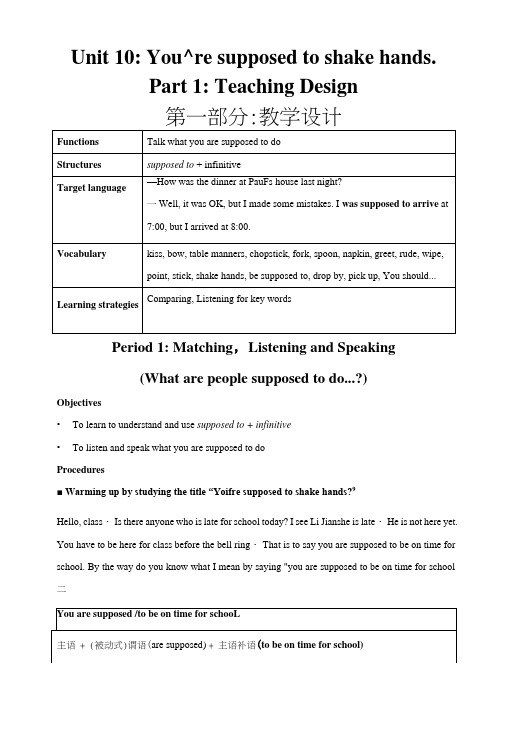
Unit 10: You^re supposed to shake hands.Part 1: Teaching Design第一部分:教学设计Period 1: Matching,Listening and Speaking(What are people supposed to do...?)Objectives•To learn to understand and use supposed to + infinitive•To listen and speak what you are supposed to doProcedures■ Warming up by studying the title “Yoifre supposed to shake hands?9Hello, class・ Is there anyone who is late for school today? I see Li Jianshe is late・ He is not here yet. You have to be here for class before the bell ring・ That is to say you are supposed to be on time for school. By the way do you know what I mean by saying "you are supposed to be on time for school 二be supposed to...其中to是动词不定式符号,不是介词,其后要跟动词原形。
当be supposed to...的主语是“人”时,意为“应该……”;“被期望……”,它可以用來表示劝告、建议、义务、责任等,相当于情态动词should。
如:Everyone is supposed to wear a seat-belt in the car.每个人在汽车里都应该系安全带。
Unit 10 How Reading Makes Us More Human

教学建议: 1. 本章重点:理解“精神阅读”对人的重要 性。 2. 本章难点:“精神阅读”或触及灵魂的 “深层阅读”的含义。 3. 课时安排:精读4学时。
☆ Pre-reading Activities
☆ Passage Exploration ☆ Post-reading Activities
Death of a Salesman
Death of a Salesman: it is a 1949 play written by American playwright Arthur Miller. It was the recipient of the 1949 Pulitzer Prize for Drama and Tony Award for Best Play.
Example
★ He passes for a scholar.
★ a material that will pass for silk
Words and Expressions
utilitarian adj. made to be useful rather than decorative
Example
Madame Bovary
Madame Bovary : it is the French writer Gustave Flaubert’s debut novel in 1856. The story focuses on a doctor’s wife, Emma Bovary, who has adulterous affairs and lives beyond her means in order to escape the banalities and emptiness of provincial life.
中职《英语基础教程》第一册Unit10-3
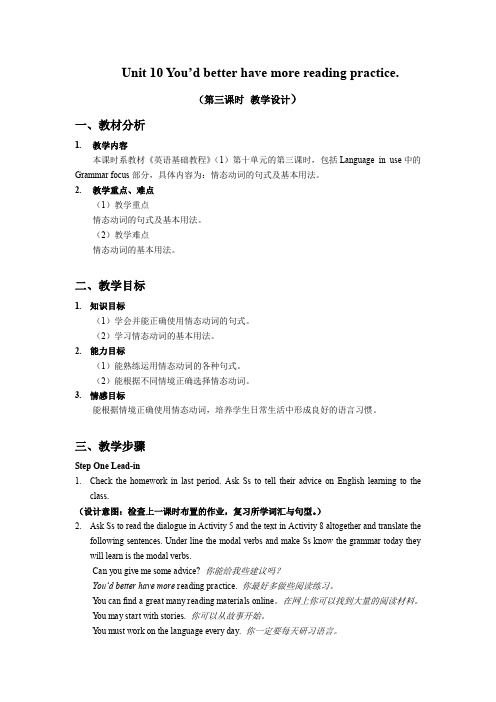
Unit 10 You’d better have more reading practice.(第三课时教学设计)一、教材分析1.教学内容本课时系教材《英语基础教程》(1)第十单元的第三课时,包括Language in use中的Grammar focus部分,具体内容为:情态动词的句式及基本用法。
2.教学重点、难点(1)教学重点情态动词的句式及基本用法。
(2)教学难点情态动词的基本用法。
二、教学目标1.知识目标(1)学会并能正确使用情态动词的句式。
(2)学习情态动词的基本用法。
2.能力目标(1)能熟练运用情态动词的各种句式。
(2)能根据不同情境正确选择情态动词。
3.情感目标能根据情境正确使用情态动词,培养学生日常生活中形成良好的语言习惯。
三、教学步骤Step One Lead-in1.Check the homework in last period. Ask Ss to tell their advice on English learning to theclass.(设计意图:检查上一课时布置的作业,复习所学词汇与句型。
)2.Ask Ss to read the dialogue in Activity 5 and the text in Activity 8 altogether and translate thefollowing sentences. Under line the modal verbs and make Ss know the grammar today they will learn is the modal verbs.Can you give me some advice? 你能给我些建议吗?You’d better have more reading practice. 你最好多做些阅读练习。
You can find a great many reading materials online。
七下unit10阅读教学设计
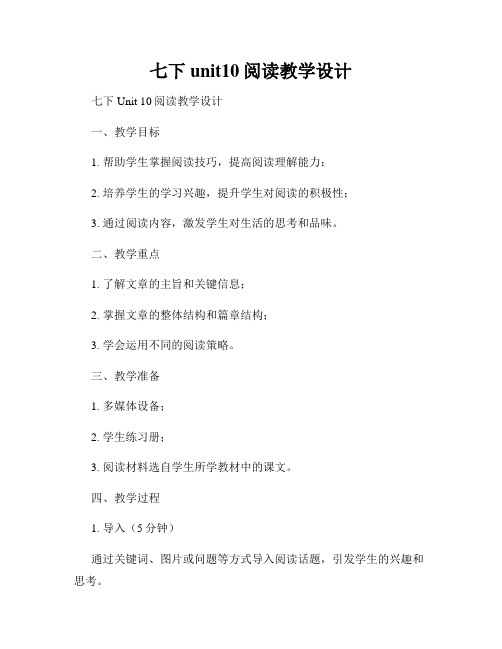
七下unit10阅读教学设计七下Unit 10阅读教学设计一、教学目标1. 帮助学生掌握阅读技巧,提高阅读理解能力;2. 培养学生的学习兴趣,提升学生对阅读的积极性;3. 通过阅读内容,激发学生对生活的思考和品味。
二、教学重点1. 了解文章的主旨和关键信息;2. 掌握文章的整体结构和篇章结构;3. 学会运用不同的阅读策略。
三、教学准备1. 多媒体设备;2. 学生练习册;3. 阅读材料选自学生所学教材中的课文。
四、教学过程1. 导入(5分钟)通过关键词、图片或问题等方式导入阅读话题,引发学生的兴趣和思考。
2. 预测与问题提出(10分钟)提出一系列问题,让学生预测文章内容,并根据问题的要求培养学生获取信息的能力和提出问题的能力。
3. 阅读与答案解析(30分钟)学生阅读课文,根据所掌握的阅读技巧和策略,有针对性地获取信息,并解答老师提出的问题。
老师在这个过程中可以适时提供必要的提示和指导。
4. 分组合作(15分钟)将学生分成小组,要求每个小组成员根据自己的角色与任务进行合作,讨论并整理所获得的信息。
鼓励学生发表自己的观点,提高表达能力。
5. 学业延伸(10分钟)提供一些与文章相关的额外阅读材料,供学生自愿阅读,进一步拓展他们的知识面。
6. 总结归纳(5分钟)对本节课的教学内容进行总结,帮助学生复习和巩固所学知识。
五、教学延伸1. 阅读材料可根据教材内容适度调整,增加一些生活实例或文化背景,以增强学生的阅读兴趣和理解能力;2. 可以进行一些与文章主题相关的讨论活动,激发学生的思维和表达能力;3. 可以通过与其他科目的连线,扩展阅读教学的应用领域。
六、教学反思本节课通过多种阅读策略和教学手段,使学生在主动参与的过程中提高了阅读理解能力。
同时,引导学生进行合作学习,培养了团队合作精神和交流能力。
通过阅读文本,学生可以进一步了解和思考生活中的问题和现象,提高他们的思辨和应变能力。
在今后的教学中,我将更加注重培养学生的阅读兴趣和阅读能力,使阅读教学更加有效和有趣。
九年级英语下册 Unit 10 Lesson 55 Look into the Future教学设计 (新版)冀教版
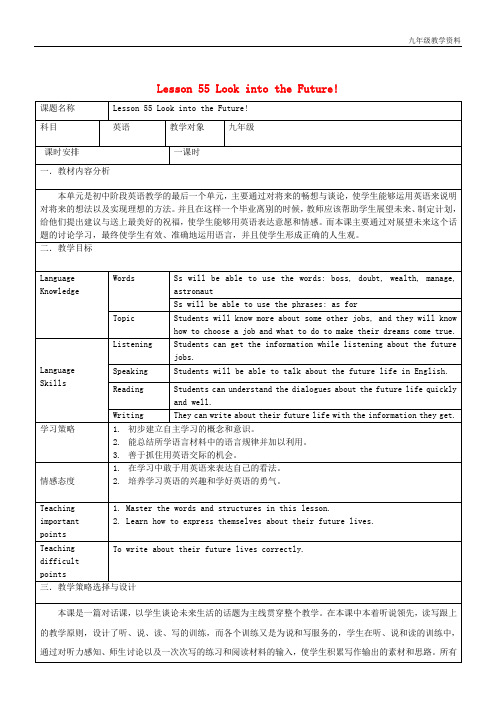
2. Ss check the answer in it:
S1: Brian would like to be a boss. He would manage a big company and make a lot of money.
Language
Skills
Listening
Students can get the information while listening about the future jobs.
Speaking
Students will be able to talk about the future life in English.
1. Ss answer the teachers questions freely:
A cook cooks delicious food.
…
2. Ss listen and learn about the phrases: create new dishes, fly a plane, invent new things.
What does an engineer do?
2. The teacher tells them: A cook can also create new dishes. A pilot can fly a plane. An engineer can invent new things.
3. Teacher shows them the first picture and asks what he does to learn the new words: boss, manage. The same way to learn astronaut.
人教版八年级下册英语 Unit 10 教学设计

B: Yes, I do.A: How long have you had it?B: I’ve had it for three years.2. Get the students to practice the conversations.Step 4 Listening (1b)1. Get the students to discuss the picture.2. Let the students listen to the tape and answer the questions:What’s the relationship between Amy and Jeff?What things did Amy ask about?3. Listen again and check the facts they hear.Step 5 Presentation and Practice (1c)1. Get the students to read the conversation.2. Let Ss make conversations about other things in the picture in pairs. Step 6 Listening (2a, 2b)1. Get the students to discuss the picture.Do you have …?How long have you had it?Which one will you give away? Why?Which one will you keep? Why?2. Get the students to listen to the tape and check the things A my’sKnowledge Aims:Words and phrases: Junior, junior high school, clear out, bedroom, no longer, own, railway, part, part with, certain, as for, honest, to be honest, while, truthfulAbility Aims:1. Students can understand the passage about the yard sale.2. Students practice reading and writing with the language chunks.1. Show the students some questions:Who is Linda? Who is Amy? What does she want to do? What things has Amy brought?How long has Amy or her mom had them?2. Read the conversation and check the answers.3. Play the tape for the students to listen and imitate.4. Ask some pairs to try to role-play the conversation.Step 3 Before reading1. Show students a mind map of the new words to consolidate the new words.2. Watch news report about “The famil y are having a yard sale”.3.Predict (Show the picture in 3a)What’s his family going to sell at the yard sale?A. a train and r ailway setB. toy monkeyC. planeStep 4 While reading1. Fast readingAsk the students to skim the passage.1) Check their predictions.2) Try to answer the question:Do you think it comes from a newspaper or a book?How do you know?What is his family going to sell at the yard sale?2 Careful reading1) Read Para. 1 to answer the following questions:Why did they decide to have a yard sale?What do they want to do with the money from the sale?What do they want to sell?Why does the son want to keep his train?2) Read Para. 2 to answer the fallowing questions:What did I want to sell?Why did I want to sell it?3) Read the whole passage and answer the questions. (3b)4) Students read the whole story and find out the difficult points.5) Discuss and try to use the useful expressions in groups.grow up; junior high school; in a yard sale; clear out; decide to do sth; play with; want to do sth.; part with; as for; give up; to be honest; do with6) Retell the story according to the mind map.Step 5 After reading (3c)1. Ask the students to talk about and finish 3c in groups.2. Show their answers.2. The students read the grammar and fill in the blanks:1) --- How long _________ you had that bike over there?--- I’ve had it _________ three years.2) --- How long _________ his son owned the train and railway set?--- He’s owned it _________ his fourth birthday.3) --- _________ you ever played football?--- Yes, I did when I was little, but I _________ played for a while now.3. Explain the distinction between since and for.for与since都能与现在完成时连用,但区别较大:a. for后须接“时间段”He has studied English for five years.b. since后须接“时间点”He has studied English since 1999.c. 二者可以转换for + 一段时间 = since + 一段时间 + agoHe has been here for five weeks. = He has been here since five weeks ago.d. 二者引出的时间状语往往用 how long提问。
初中英语第十单元讲解教案
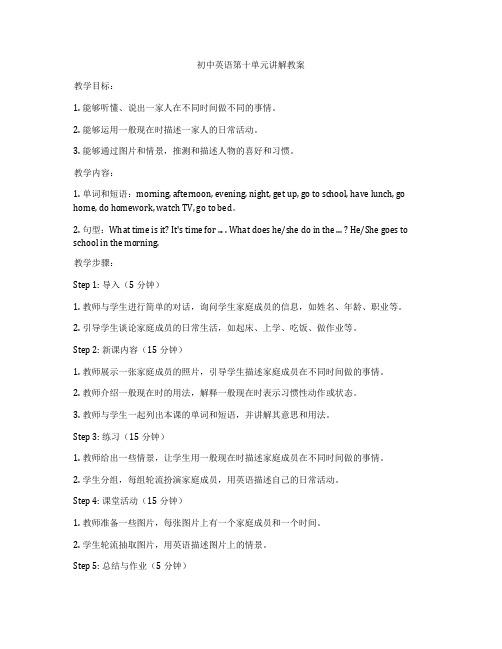
初中英语第十单元讲解教案教学目标:1. 能够听懂、说出一家人在不同时间做不同的事情。
2. 能够运用一般现在时描述一家人的日常活动。
3. 能够通过图片和情景,推测和描述人物的喜好和习惯。
教学内容:1. 单词和短语:morning, afternoon, evening, night, get up, go to school, have lunch, go home, do homework, watch TV, go to bed。
2. 句型:What time is it? It's time for ... . What does he/she do in the ... ? He/She goes to school in the morning.教学步骤:Step 1: 导入(5分钟)1. 教师与学生进行简单的对话,询问学生家庭成员的信息,如姓名、年龄、职业等。
2. 引导学生谈论家庭成员的日常生活,如起床、上学、吃饭、做作业等。
Step 2: 新课内容(15分钟)1. 教师展示一张家庭成员的照片,引导学生描述家庭成员在不同时间做的事情。
2. 教师介绍一般现在时的用法,解释一般现在时表示习惯性动作或状态。
3. 教师与学生一起列出本课的单词和短语,并讲解其意思和用法。
Step 3: 练习(15分钟)1. 教师给出一些情景,让学生用一般现在时描述家庭成员在不同时间做的事情。
2. 学生分组,每组轮流扮演家庭成员,用英语描述自己的日常活动。
Step 4: 课堂活动(15分钟)1. 教师准备一些图片,每张图片上有一个家庭成员和一个时间。
2. 学生轮流抽取图片,用英语描述图片上的情景。
Step 5: 总结与作业(5分钟)1. 教师与学生一起总结本课所学内容,重点是一般现在时的用法和家庭成员的日常活动。
2. 布置作业:让学生写一篇短文,描述自己家庭成员的一天。
教学评估:1. 在课堂活动中,教师观察学生的语言表达能力和听力理解能力。
初中英语_人教版2013新目标九年级unit10 Section A(3a教学设计学情分析教材分析课后反思

教学过程第一学时教学目标➢Knowledge aims: Students are able to understand the meaning of the following words and phrases: be relaxed about, value the time, drop by, after all, avoid, make an effort to.➢Ability aims: Students are able to get to know the customs in many countries, esp. in Colombia and Switzerland. They can talk about the customs of China and other countries. Role play a conversation about different customs.➢Moral aims: When in Rome do as Romans do.学点难点➢Understand the article and the customs of Colombia and Switzerland.And Role play a conversation about different customs.教学设计I Warm up and lead in (3`)A fun game: That’s me.(Purpose: To lead in the topic, arouse students' interest and be prepared for reading.)II Reading circle (17`)Before-reading: read the pictures of the article.(Purpose: To learn to read pictures to get some information.)While-reading:1. Read and choose.2. Read and fill in the blanks of two parts about the customs. Boys for one part, girls for the other part. Then share their answers in group.3. Ask more questions to let students get a better understanding of the passage when checking the answers.(Purpose: To get to know the details of the article and understand different customs.)Post-reading: Sum up and retell the article.(Purpose: To help each other in a group to understand the main idea of the article.)III Role play (13`)●Watch a period of video to get the reason why Marc is mad.●Make up a conversation in group according to the situation.●Show time: role play the conversation.●Answer a question: why are they arguing?(Purpose: To complete a real task by using the target language.)IV 2. Think and share: What are our customs about the three points in the passage? Other ?V Homework (1`)1. You must:Tell your family the customs of Colombia and Switzerland.2. You May:Search for more information about different customs in different countries.学情分析任教班级为九年级学生,班级学生比较活泼好动,在英语上依然保持一定的学习热情,有了初步的自我意识,具备一定的评价能力,逻辑思维能力、抽象思维能力日益发展成熟,这些都为他们的学习提供了有利的条件。
英语六年级上册《unit_9-10》word教案
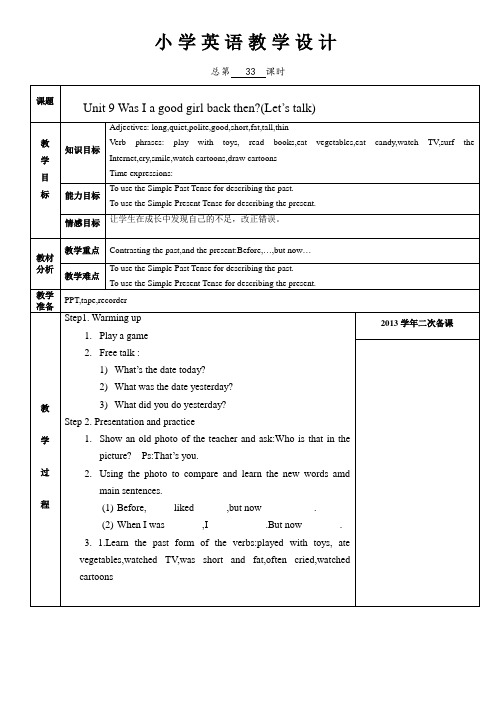
Using the Simple Past and the Simple Present Tense for talking about changes.
教学准备
PPT,tape
教
学
过
程
Step1. Warming up
1、Sing a song: London Bridge is falling down
Step 2 Presentation andpractice
1. Do Task 3 read and write in Fun With Language.
1) ing the pictures that have appeared in this unit to highlight the point that when people grow up, sometimes they may look very different from what they looked like when they were young.
Look at Task 1 on Page 52.
2.Ask pupils to study the 5 sets of pictures and guess the changes that those people have had.
3.Explain the listening task.Play the recording,pausing after each question for pupils to put down the correct number.
Step 3Look and Write
2013学年二次备课
教
学
过
程
冀教版九年级全一册英语 Lesson 10 教案(教学设计)

Unit 2 Great People Lesson 10 Touch the World单词planetary,writer,educator,blind,掌握本课的词汇和短语。
掌握状语从句和定语从句的运用。
Step 1:Leading-in多媒体展示海伦·凯勒的图片。
T:Boys and girls,look at the picture. Who is she,can you tell me?Ss:Yes. She is Helen Keller.T:Yes,very good. What is she famous for?Ss:(帮助学生回答)She is a well-known writer and educator.T:Yes,Helen Keller is deaf and blind. But how could she overcome it? Ss:...T:OK. Let’s learn Lesson 10 to learn more about Helen Keller. Ready?Go!设计意图:图片导入本课话题,师生互动,激发学生的学习兴趣,创设轻松的学习氛围,开发他们的最大潜能,从而使这堂课在最大程度上达到最高效能Step 2:Pre-readingLook at the pictures and learn the new words.大屏幕展示生词的图片,学习新单词,然后进行“头脑风暴”游戏,看谁记住的单词最多。
Present the new words:planetary,writer,educator,blind,deaf,illness,ability,progress,community,greatly.Show some pictures of the new words on the screen. Ask Ss to try to read these words. 设计意图:图片教学法是呈现新知识最简单有效的方法之一,学生通过图片,能更直观地理解新单词的含义。
- 1、下载文档前请自行甄别文档内容的完整性,平台不提供额外的编辑、内容补充、找答案等附加服务。
- 2、"仅部分预览"的文档,不可在线预览部分如存在完整性等问题,可反馈申请退款(可完整预览的文档不适用该条件!)。
- 3、如文档侵犯您的权益,请联系客服反馈,我们会尽快为您处理(人工客服工作时间:9:00-18:30)。
新目标(Go for it!)9年级
Unit10 You’re supposed to shake hands. Section B Reading 阅读课教学设计
environment, traffic and so on.
(Purpose:为语篇阅读做好铺垫)
3.Pre-reading.
Have students to observe what kind of article they are going to read, teacher asks questions: What kind of article is it? ---A letter.
Who wrote it and whom did it write to? ---Lin Yue wrote it to Laura. (Purpose:了解语篇类型,获取文章的背景信息)
4.While-reading
1)Skimming
Students skim the letter for the main idea.
Q1. Where is Lin Yue? ---In France
Q2. Why is she there? ---She is on her student exchange program.
Q3.What does Lin Yue tell Laura in the letter?---Her life as an exchange student in France. (Purpose:快速阅读获取文章的main idea)
2)Scanning
First, students scan the letter and find the challenges Lin Yue have, as well as the biggest challenges among them.
Then ask students to scan again, answer the questions:
Q1.How did she feel before arriving there? ---Nervous
Q2.Does she still feel like that? ---No. There was no reason to be nervous.
Teacher asks the students to think: Why does she not feel nervous now?
Then lead the students to know that she may have dealt with her challenges successfully , so she doesn’t feel nervous anymore.
Teacher going on asking the students: Who helped her deal with her challenges?
Students can find it easily that her host family helped her.
(Purpose:快速阅读找出作者所面对的挑战,通过作者思想的变化推测出她成
功的处理了挑战,进而过渡到细读:寄宿家庭如何帮助她处理挑战。
)
3). Para 1. Reading for details
First, teacher ask the questions to lead students read and find the supporting details.
Q1. How is her host family?
Q2. How do the families help her deal with the challenges?
Teacher writes the answers on the blackboard, and then build the mind-map.
Students read again and answer:
Q3. How does she feel about speaking French now?
(Purpose:细读以获取细节信息:寄宿家庭如何帮助她处理language和food 的挑战,通过思维导图,学生而整体感知到细节理解。
)
4).Para2 Reading for details
Students read and answer:
Q1.Why is learning table manners her biggest challenge? ---
French table manners are different from the table manners in her own country.
Q2. What did she think of French table manners?
How does she feel now?
(Purpose:细读以获取细节信息:作者对法国餐桌礼仪看法的改变显示出作者能很好的应对这一挑战)
5.Post-reading
1). Activity:Scan and Judge
Teacher presents four pictures about French table manners, students judge:Do
the pictures show the good table manners or bad table manners in France?
The pictures are here:
When checking the answers, students are supposed to tell what the proper table manners should be like by using the target languages, including:
You are (not) supposed to do…
You are (not) expected to do…
It’s polite/impolite to do…
(Purpose:通过辨别与判断,学生对法国餐桌礼仪有更为直观的认识,并对中西方餐桌礼仪的差别有所认识)
2). Think and share: How has Lin Yue dealt with her challenges successfully?
(Purpose:渗透健全人格教育:面对挑战时,要积极面对,通过自身努力来克服挑战,同时在自身不能很好的处理挑战时,要学会向他人寻求帮助已解决问题)
6.Discussion
Show the pictures of students in our school who took part in the summer camps to the USA, ask students to discuss and share:
What can we learn from Lin Yue’s experience as an exchange student? ---。
